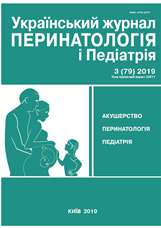Autoimmune activity in pregnant women with systemic lupus erythematosus
DOI:
https://doi.org/10.15574/PP.2019.79.10Keywords:
systemic lupus erythematosus, antiphospholipid syndrome, pregnant women, autoimmune antibodiesAbstract
In recent years, the number of autoimmune diseases has been increasing significantly worldwide, in particular, in people of reproductive age. Pregnancy is a factor in the development or exacerbation of autoimmune diseases. Purpose is to determine the spectrum of antibodies in pregnant women with systemic lupus erythematosus (SLE) depending on the damage of target organs to establish the activity of the autoimmune process, and in the future, to prescribe an adequate treatment, and to determine the prognosis.Patients and methods. We examined 96 pregnant women with SLE, among whom there were 34 women with antiphospholipid syndrome (APS) and 62 women without APS. In the group of women with SLE without APS, the I degree of activity was observed in 48 pregnant women, II degree — in 14 women. In women with SLE in combination with APS І degree of activity was observed in 22 pregnant women, ІІ degree — in 12 women. The spectrum of autoimmune antibodies was determined according to standard methods in a laboratory with European certification.
Results and conclusions. In 75% of pregnant women with SLE II degree of activity, and in almost 60% of pregnant women with SLE І degree of activity, antibodies to double-stranded DNA (dsDNA) were detected, which are a laboratory marker of SLE and are almost never found in other connective tissue diseases. Target organ lesions are observed in all pregnant women under study, however, a significantly higher percentage of carditis and pneumonitis is recorded in women with SLE II degree of activity. According to our data, there is a direct correlation between the presence of positive antibodies to double-stranded DNA (dsDNA) in high titers and lupus nephritis in pregnant women with SLE II degree of activity. In the group of pregnant women with SLE and APS, using a quantitative method for assessing the risk of thromboembolic complications, an extremely high risk of thrombosis was identified, which necessitates effective thromboprophylaxis.
The research was carried out in accordance with the principles of the Helsinki Declaration. The study protocol was approved by the Local Ethics Committee of participating institution. The informed consent of the patient was obtained for conducting the studies.
No conflict of interest were declared by the authors.
References
Davydova Yu, Shevchuk E, Limanskaya A, Garmish E, Ogorodnyk AA. (2016). The features of pregnancy and delivery in pregnant women with systemic lupus erythematosus and antiphospholipid syndrome. Perinatologiya i pediatriya. 2016. 2(66): 9—13. doi 10.15574/PP.2016.66.9
Carvalheiras G, Vita P, Marta S, Trovao R, Farinha F, Braga J, Rocha G, Almeida I, Marinho A, Mendonca T et al. (2010). Pregnancy and systemic lupus erythematosus: review of clinical features and outcome of 51 pregnancies at a single institution. Clin Rev Allergy Immunol. 38 (2—3): 302—306. https://doi.org/10.1007/s12016-009-8161-y; PMid:19603147
Hutter D, Silverman ED, Jaeggi ET. (2010). The benefits of transplacental treatment of isolated congenital complete heart block associated with maternal anti-Ro/SSA antibodies: a review. Scand J Immunol. 72 (3): 235—241. https://doi.org/10.1111/j.1365-3083.2010.02440.x; PMid:20696021
Kwok LW, Tam LS, Zhu T, Leung YY, Li E. (2011). Predictors of maternal and fetal outcomes in pregnancies of patients with systemic lupus erythematosus. Lupus. 20 (8): 829—836. https://doi.org/10.1177/0961203310397967; PMid:21543513
Lateef A, Petri M. (2012). Management of pregnancy in systemic lupus erythematosus. Nat Rev Rheumatol. 8 (12): 710—718. https://doi.org/10.1038/nrrheum.2012.133; PMid:22907290
Downloads
Issue
Section
License
The policy of the Journal “Ukrainian Journal of Perinatology and Pediatrics” is compatible with the vast majority of funders' of open access and self-archiving policies. The journal provides immediate open access route being convinced that everyone – not only scientists - can benefit from research results, and publishes articles exclusively under open access distribution, with a Creative Commons Attribution-Noncommercial 4.0 international license(СС BY-NC).
Authors transfer the copyright to the Journal “MODERN PEDIATRICS. UKRAINE” when the manuscript is accepted for publication. Authors declare that this manuscript has not been published nor is under simultaneous consideration for publication elsewhere. After publication, the articles become freely available on-line to the public.
Readers have the right to use, distribute, and reproduce articles in any medium, provided the articles and the journal are properly cited.
The use of published materials for commercial purposes is strongly prohibited.

